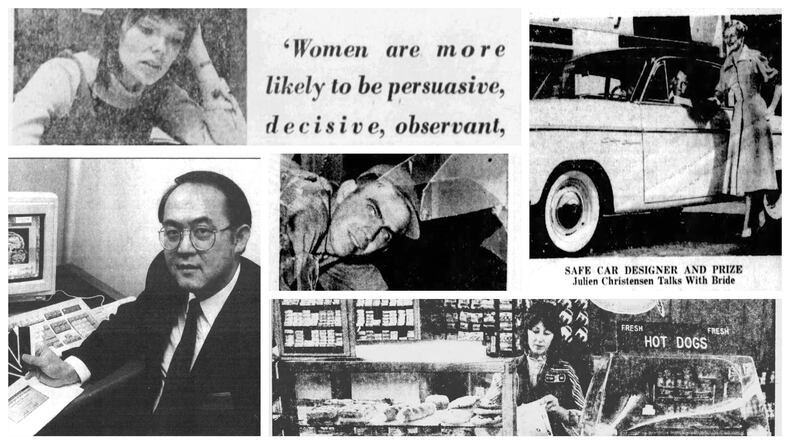Here’s a look at some stories from the week of March 24-30.
March 28, 1954: Daytonian wins nationwide ‘Safe Car’ contest
Julien M. Christensen used a combination of psychology, physiology, anthropology and airplane design principals to win the top prize in a nationwide “Safe Car” contest.
Christensen, 35, was the assistant chief of the psychology branch of the Aero Medical laboratory at Wright-Patterson Air Force Base.
Among his accomplishments were designing the U.S. Air Force B-2 navigation plotter, authoring 31 technical papers in a variety of fields, making extensive flights as a civilian to study Air Force navigation requirement and being the first civilian to fly over the North Pole with the Air Force.
His latest prize (a hard-top sports car) was for proposing a car that would incorporate safety lessons learned in aircraft research. There were 2,395 entrants in the contest sponsored by Science & Mechanics magazine.
Christensen won the prize right around the time he was getting married to Imogene Willis, of Dayton, who had recently won a prize herself. She was named, “Miss Navy of 1953.” The two met at an Armed Forces show.
March 25, 1964: Dynamite bombs found at 2 building projects
Non-union workers were the apparent targets of bundles of dynamite set to go off at two Dayton apartment construction jobsites.
Eight sticks were discovered in a four-family apartment house near completion just of Siebenthaler Avenue. Six sticks were found at the Georgetown of Kettering project on Far Hills Avenue.
The shoe boxes filled with dynamite were both wired to alarm clocks to go off at 2 p.m.
“When I heard it ticking, I called the foreman,” one worker said.
Explosives ordnance disposal experts from Wright-Patterson Air Force Base were called in to dismantle that bomb.
“If it would have gone off, it would have blown the place sky high,” one official said.
Police said the project had been picketed as a non-union construction job.
March 25, 1974: Police adjusting for new wave of female cops
Dayton was soon to have women street cops in 1974.
The police department’s 56th recruit class included six females who would be graduating from the police academy within a month.
Some of the male officers were against having female counterparts, saying they would have to be “watched and protected” in violent incidents and might distract the males from taking care of a situation.
Or, as another feared, a man and a woman working together could become romantically involved, destroying family relationships. Working and riding side by side in a car all day is different from working together in an office, he said.
An evaluation specialist was called in to collect information from police departments across the nation with female officers to see it the fears were justified.
A study concluded that “women are more likely to be persuasive, decisive, observant, emotionally stable, intelligent, understanding and compassionate.” The men were “more likely to be strong and aggressive.”
Firing a gun was apparently done more easily by a male, the study concluded, but only two women were dropped from the recruit class when they failed to pass firearms tests.
March 25, 1984: Sun Co. sees rising future in Stop-N-Go
In 1983, Sun Co. (Sunoco) owned three convenience store chains: Stop-N-Go Food Stores, Fast Fair and Zippy Mart.
By 1984 it had sold the 500-plus Fast Fair and Zippy stores, leaving Stop-N-Go as the survivor.
Unlike the others, Stop-N-Go, which had it’s national headquarters in Englewood, expected to stay.
Plans for Stop-N-Go included the upcoming additions of car washes, bank machines, money-dispensing can crushers and strudel. The neighborhood stores were to be open 24 hours a day.
That year, Stop-N-Go, which had 468 stores, planned to open 20 new stores, 10 each in southern Ohio and the Philadelphia area.
Popular items at Stop-N-Go were the three hot dogs for 99 cents, spill-proof coffee cups and “Guzzler” 32-ounce fountain soft drinks.
March 29, 1994: Blue Chip Computers anticipates health reform
In the 1970s, Larry Song worked in hospitals developing patient information systems. Two decades later, he was back at it again.
His latest patient information system involved using optical memory cards, the size of a credit card, that could hold up to 2,000 pages of medical data, including images from CAT scans and X-rays.
In the 20 years away from hospitals, Song had worked on developing flood forecasting models for the Miami Conservancy District, managed a retail computer store, automated warehouses for Sohio (which became BP), developed new cash register technology, owned restaurants and built Blue Chip Computers into a $9.5 million information engineering company.
Seven Dayton-area hospitals had just launched fiber-optic telecommunications networks to move patient records electronically. Song and Blue Chip were scrambling to get a piece of that health care market.
At the time, the growing Blue Chip company had 52 employees and a roster of clients that included AT&T, Bank One, EG&G Mound, British Petroleum and the U.S. Air Force.
About the Author






